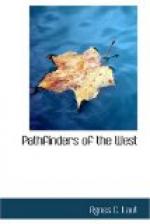For years the dispute has been waged with zeal worthy of a better cause whether Radisson referred to Hudson Bay in this passage. The French claim that he did; the English that he did not. “The house demolished with bullets” was probably an old trading post, contend the English; but there was no trading post except Radisson’s west of Lake Superior at that time, retort the French. By “cows” Radisson meant buffalo, and no buffalo were found as far east as Hudson Bay, say the English; by “cows” Radisson meant caribou and deer, and herds of these frequented the shores of Hudson Bay, answer the French. No river comes from the Saguenay to Hudson Bay, declare the English; yes, but a river comes from the direction of the Saguenay, and was followed by subsequent explorers, assert the French.[11] The stones of turquoise and green were agates from Lake Superior, explain the English; the stones were labradorites from the east coast of the Bay, maintain the French. So the childish quarrel has gone on for two centuries. England and France alike conspired to crush the man while he lived; and when he died they quarrelled over the glory of his discoveries. The point is not whether Radisson actually wet his oars in the different indentations of Hudson and James bays. The point is that he found where it lay from the Great Lakes, and discovered the watershed sloping north from the Great Lakes to Hudson Bay. This was new ground, and entitled Radisson to the fame of a discoverer.
From the Indians of the bay, Radisson heard of another lake leagues to the north, whose upper end was always frozen. This was probably some vague story of the lakes in the region that was to become known two centuries later as Mackenzie River. The spring of 1663 found the explorers back in the Lake of the Woods region accompanied by seven hundred Indians of the Upper Country. The company filled three hundred and sixty canoes. Indian girls dived into the lake to push the canoes off, and stood chanting a song of good-speed till the boats had glided out of sight through the long, narrow, rocky gaps of the Lake of the Woods. At Lake Superior the company paused to lay up a supply of smoked sturgeon. At the Sault four hundred Crees turned back. The rest of the Indians hoisted blankets on fishing-poles, and, with a west wind, scudded across Lake Huron to Lake Nipissing. From Lake Nipissing they rode safely down the Ottawa to Montreal. Cannon were fired to welcome the discoverers, for New France was again on the verge of bankruptcy from a beaver famine.
A different welcome awaited them at Quebec. D’Argenson, the governor, was about to leave for France, and nothing had come of the Jesuit expedition up the Saguenay. He had already sent Couture, for a second time, overland to find a way to Hudson Bay; but no word had come from Couture, and the governor’s time was up. The explorers had disobeyed him in leaving without his permission. Their return




